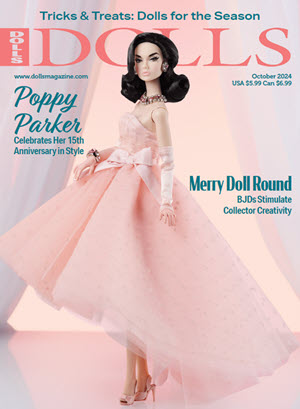
By The Doll Historian
Rose of Versailles, an animated television series that ran from 1979 to 1980 in Japan, was based on a comic book by Riyoko Ikeda. Set in France in the 18th century, it tells the story of fictional character Lady Oscar François de Jarjayes, whose father had wanted a son and heir. After another daughter was born to the family, her father decided to raise her like a son, naming her Oscar and teaching her how to fight. Years later, she would be sent to the Palace of Versailles to become a bodyguard for a recently arrived princess, Marie Antoinette.
Having been raised as a general’s heir, Lady Oscar was given opportunities that weren’t always available to women at the time. But it wasn’t without its challenges. Parts of the story revolve around her encountering sexism while trying to be true to herself and balancing the expectations of her job.
Over the years, the story has been adapted into various stage musicals, as well as a live action film (1979) that was a co-production between French and Japanese film studios. However, the animated show just might be the most well-known incarnation. The show’s directorial style and aesthetics became iconic and have had a major influence on Japanese animation.
Although already a popular franchise in Japan and many parts of Europe, the animated series didn’t arrive in the U.S. until a DVD was released in 2013. As a result, the series is more obscure in North America, although it has gained traction.

Products of the Franchise
The Versailles Palace dollhouse was released in Japan circa the late 1970s or early 1980s. On the front, it has an illustration of Lady Oscar and Marie Antoinette, looking like they stepped right out of an episode. The building’s roof is made of molded plastic with some stickers for the windows. The palace is designed to fold and unfold for easy storage.
Measuring about 14 inches high, the walls add an extra 10 inches on each side once the dollhouse is opened. It is smaller than other dollhouses from that time. A 12-inch fashion doll can still stand up in front of the room, but it is out of proportion with the scenery, which feels more like a background here. There are 6-inch versions of the dolls, so it’s likely the building was designed for them instead.
The room interiors are elaborately designed, with colorful graphics depicting a ballroom and a balcony. One has to wonder who provided the artwork for these releases. The Lady Oscar and Marie Antoinette character designs were taken from the TV show, but information regarding who drew the rest of the dollhouse art is not readily available. The interior illustrations would have been especially important because this was before the age of giant plastic dollhouses or elaborate moving parts. Without the artwork, all you’d have is a blank box.
While the dollhouse remains rare, the 1970s Rose of Versailles dolls are more plentiful, albeit expensive. There are multiple versions of the Lady Oscar and Marie Antoinette dolls — Marie usually wears a red gown, while Lady Oscar wears either a red or blue soldier’s uniform. The Lady Oscar doll pictured here is about the size of a Barbie and was originally found wearing a 1970s Barbie dress. She is now borrowing an outfit from a Ken prince set instead. It’s not a perfect match, time-period wise, and the sleeves are a bit long, but it’s close enough.
It’s currently unknown if other characters were included in the initial release, but it would make sense for there to have been dolls based on supporting characters like Rosalie. Also unknown is whether these dolls and the dollhouse were released around the world or if they were exclusive to Japan.
In 2022, to celebrate the series’ 50th anniversary, it was announced that a new animated Rose of Versailles film was in production. However, there has been sparse mention of the project since that initial announcement. It remains to be seen whether Rose of Versailles will make a return and captivate new and existing audiences. If it does, there are sure to be more dolls and accompanying accessories in our future.






